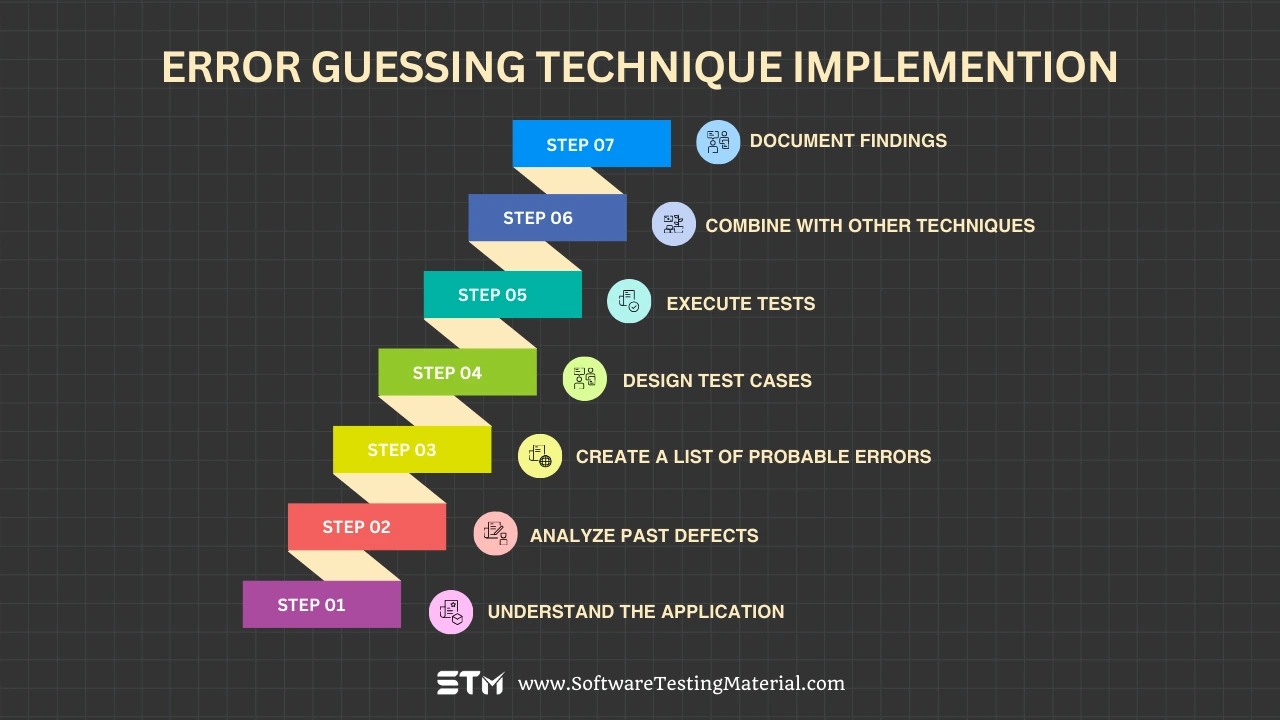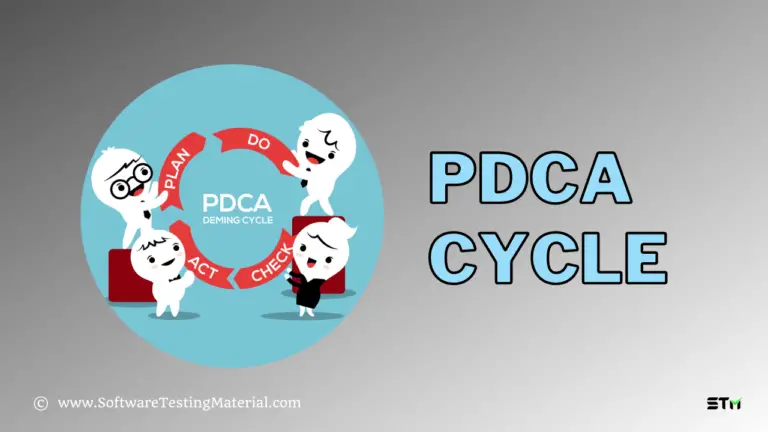Error Guessing Technique In Software Testing
Error Guessing is used in software testing to identify defects by anticipating errors that may occur in the application. This technique relies on the tester’s experience and intuition to predict potential problem areas in the software. Testers use their knowledge of past issues, common mistakes, and system behavior to design test cases that specifically target these errors.
Unlike other structured techniques, Error Guessing does not follow strict rules or procedures, making it a flexible and creative approach for uncovering hidden defects. It helps improve the overall quality of the software by addressing scenarios that might otherwise be overlooked.
What is Error Guessing Technique?
Error guessing is a test case design technique where the tester uses their knowledge, experience, and intuition to predict where errors might exist in the application. Instead of following strict rules or predefined steps, the tester thinks about what could go wrong in specific areas of the software.
This approach often involves asking questions like, “What input values might cause the system to crash?” or “Which actions are likely to be mishandled by the application?” By making educated guesses, the tester can identify potential problems that other methods might overlook. This technique works best when combined with other testing methods to ensure thorough coverage.
How to Implement the Error Guessing Technique?

Implementing the error guessing technique requires a structured approach that relies on the experience and intuition of the tester. Below are the steps to follow for effectively using this technique:
- Understand the Application: Start by gaining a deep understanding of the application or system under test. Learn how it works, what its key functionalities are, and how users are expected to interact with it. This helps you predict areas that may be prone to errors.
- Analyze Past Defects: Review previous defects or issues faced in similar applications or previous versions of the current application. Patterns from past errors can guide you in predicting potential problem areas in the current system.
- Create a List of Probable Errors: Based on your knowledge and past analysis, create a list of potential issues that might occur. For example, you might consider scenarios like entering invalid data, exceeding field limits, or triggering edge cases that may not have standard handling.
- Design Test Cases: Develop test cases based on the error-prone areas you have identified. These test cases should aim to uncover problems by mimicking user behavior that could lead to system failures, such as entering unsupported file formats or performing unexpected actions.
- Execute Tests: Run the test cases you have designed and observe how the application behaves. Check whether the application handles unexpected inputs or actions gracefully or if it fails to perform as expected.
- Combine with Other Techniques: Use error guessing alongside other testing techniques, like boundary value analysis or equivalence partitioning, to ensure thorough testing. Combining methods increases the chances of uncovering hidden errors.
- Document Findings: Record the results of your tests, including details about any errors found and how they occurred. This information can be valuable for developers to fix the issues and for future testing efforts.
By following these steps, the error guessing technique can be a powerful addition to your testing strategy, helping you discover vulnerabilities that might otherwise go unnoticed.
Purpose of Error Guessing
The purpose of error guessing is to find errors or bugs in a system based on experience and intuition. Testers use their knowledge about common mistakes or weak points in similar systems to predict where issues might exist.
By applying this technique, testers can uncover problems that may not be detected by other structured testing methods. This approach helps improve the overall quality and reliability of the system before it is released.
Examples of Error Guessing Technique
#1. Login Page Validation
A tester might guess that the login page could have issues when handling invalid inputs. For example,
- Test scenarios like entering a very long username
- Leaving the password field blank
- Using special characters in both fields
Using the error guessing technique, the tester could identify issues such as poor error messages, incorrect field validations, or even system crashes when these scenarios are tested.
#2. File Upload Functionality
Another example is testing a file upload feature. Based on experience, a tester might suspect areas where errors could happen such as
- Uploading files larger than the allowed size
- Uploading unsupported file formats
- Uploading a file when there is no internet connection
By checking these edge cases, the tester could uncover problems like incorrect error handling, slow response times, or blocked functionality.
Advantages and disadvantage of Error Guessing Technique
Advantages of Error Guessing Technique
- Saves Time and Effort: By identifying potential problem areas through experience, this technique helps testers focus on likely errors, saving time and effort that might be spent on exhaustive testing.
- Enhances Formal Testing: Error guessing complements structured testing techniques by addressing areas that formal tests might miss.
- Targets Complex Areas: It allows testers to focus on challenging or less obvious parts of the software, increasing the likelihood of finding hidden bugs.
- Relies on Experience: Skilled and experienced testers can use their knowledge to predict and uncover errors effectively.
- Flexible Approach: There are no strict rules or patterns, allowing it to be used in various scenarios, making it an adaptable testing method.
- Early Detection of Bugs: The technique can reveal bugs at an early stage that might otherwise go undetected until later in development.
Disadvantages of Error Guessing Technique
- Heavily Human-Oriented: The success of this technique relies on the tester’s experience and intuition, making it dependent on individual skills rather than a structured process.
- Risk of Limited Test Coverage: Since it focuses on guessing potential errors, not all areas or test cases may be covered, which can lead to undetected issues.
- Lack of Consistency: Different testers may apply the technique differently, leading to inconsistent results and uncovered bugs.
- Doesn’t Ensure Quality: This technique alone cannot guarantee the overall quality of the product, as it may leave gaps in testing.
- Not Suitable for Beginners: Testers with limited product knowledge or experience may struggle to implement this technique effectively.
- Missing Input Boundaries: It may overlook critical inputs or boundary values that require thorough testing.
By understanding both the advantages and drawbacks in detail, testers can decide when and how to use the error guessing technique effectively in their testing process.
Factors used in Error Guessing Technique
The error guessing technique relies on the tester’s experience and intuition to identify potential defects. Several factors can guide this process, including:
- Historical Defects: Knowledge of past defects in similar applications can help testers anticipate potential issues.
- Common Software Errors: Awareness of common mistakes such as boundary value errors, input/output issues, or incorrect data handling.
- Application Knowledge: Understanding the application’s workflows, limitations, and areas prone to error.
- Specification Review: Analyzing requirements and design documents to identify ambiguous or incomplete specifications.
- Edge Cases: Considering unusual or extreme scenarios that may not have been thoroughly tested during formal testing phases.
By leveraging these factors, testers can strategically uncover hidden issues in the software.
FAQs: Error Guessing Technique
Is error guessing a black box testing?
Yes, error guessing is considered a black box testing technique. This means testers do not need to know the internal workings or code of the software. Instead, they rely on their experience, intuition, and knowledge of common errors to identify issues in the application.
Is error guessing is white box testing?
No, error guessing is not a white box testing technique. White box testing requires knowledge of the internal code or structure of the software, whereas error guessing relies on the tester’s experience and does not need any understanding of the internal workings of the application. It focuses on finding errors based on patterns and common issues.
Is exploratory testing black box?
Yes, exploratory testing is a black box testing technique. It does not require knowledge of the internal code or structure of the software. Instead, testers explore the application freely, using their creativity and experience to find bugs or errors by interacting with the software from an end-user perspective.
Conclusion
Error guessing is a valuable black box testing technique that helps testers identify potential issues in software based on their experience and knowledge of common mistakes. It does not require understanding the internal workings of the application, making it accessible and effective for testing from an end-user perspective. By using error guessing along with other testing methods, teams can ensure a more reliable and high-quality software product.






